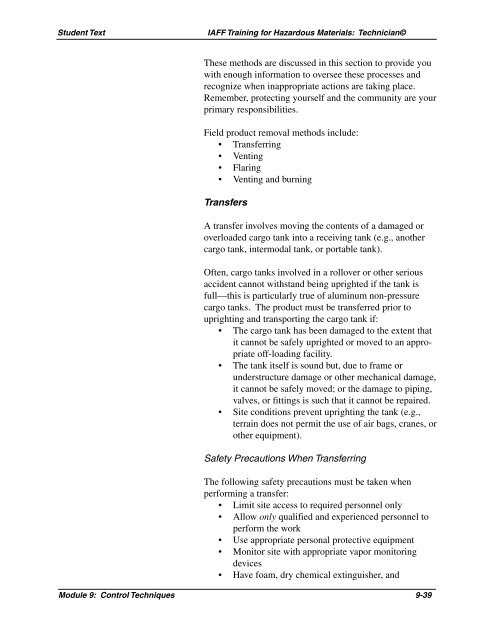Module 9: Control Techniques - International Association of Fire ...
Module 9: Control Techniques - International Association of Fire ...
Module 9: Control Techniques - International Association of Fire ...
Create successful ePaper yourself
Turn your PDF publications into a flip-book with our unique Google optimized e-Paper software.
Student Text IAFF Training for Hazardous Materials: Technician©<br />
These methods are discussed in this section to provide you<br />
with enough information to oversee these processes and<br />
recognize when inappropriate actions are taking place.<br />
Remember, protecting yourself and the community are your<br />
primary responsibilities.<br />
Field product removal methods include:<br />
• Transferring<br />
• Venting<br />
• Flaring<br />
• Venting and burning<br />
Transfers<br />
A transfer involves moving the contents <strong>of</strong> a damaged or<br />
overloaded cargo tank into a receiving tank (e.g., another<br />
cargo tank, intermodal tank, or portable tank).<br />
Often, cargo tanks involved in a rollover or other serious<br />
accident cannot withstand being uprighted if the tank is<br />
full—this is particularly true <strong>of</strong> aluminum non-pressure<br />
cargo tanks. The product must be transferred prior to<br />
uprighting and transporting the cargo tank if:<br />
• The cargo tank has been damaged to the extent that<br />
it cannot be safely uprighted or moved to an appropriate<br />
<strong>of</strong>f-loading facility.<br />
• The tank itself is sound but, due to frame or<br />
understructure damage or other mechanical damage,<br />
it cannot be safely moved; or the damage to piping,<br />
valves, or fittings is such that it cannot be repaired.<br />
• Site conditions prevent uprighting the tank (e.g.,<br />
terrain does not permit the use <strong>of</strong> air bags, cranes, or<br />
other equipment).<br />
Safety Precautions When Transferring<br />
The following safety precautions must be taken when<br />
performing a transfer:<br />
• Limit site access to required personnel only<br />
• Allow only qualified and experienced personnel to<br />
perform the work<br />
• Use appropriate personal protective equipment<br />
• Monitor site with appropriate vapor monitoring<br />
devices<br />
• Have foam, dry chemical extinguisher, and<br />
<strong>Module</strong> 9: <strong>Control</strong> <strong>Techniques</strong> 9-39
















